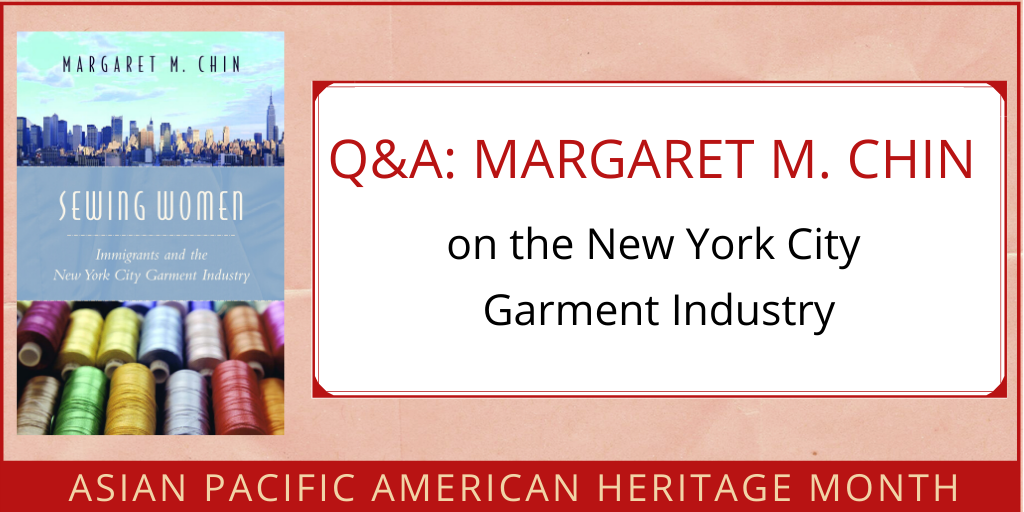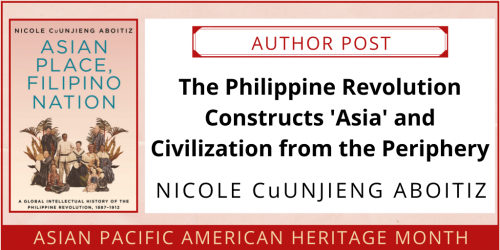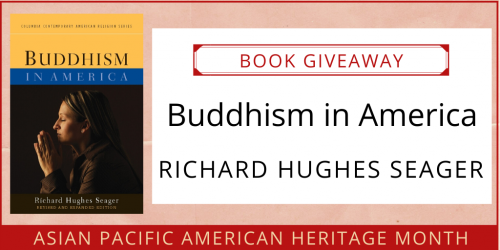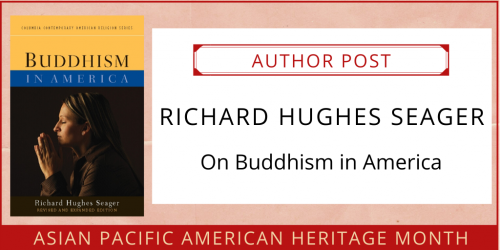Q&A: Margaret M. Chin on the New York City Garment Industry

“Sewing Women provides a new and illuminating perspective on New York’s garment industry and the dynamics of work among today’s immigrants through a carefully argued and insightful comparison of Chinese- and Korean-owned garment shops and their Chinese and Hispanic workers.”
~Nancy Foner, Distinguished Professor of Sociology, Hunter College of the City University of New York, author of From Ellis Island to JFK: New York’s Two Great Waves of Immigration
In today’s Asian Pacific American Heritage Month post, Margaret M. Chin, author of Sewing Women: Immigrants and the New York City Garment Industry, discusses the history and current state of garment work in New York City. She answers questions about the various immigrant groups that dominate the industry, the role of women in textiles, and how these factors and ideas connect to the surge in sewing masks during the coronavirus pandemic.
If you enjoy this interview, make sure to enter our giveaway of Sewing Women for a chance to win a copy!
• • • • • •
Q: Tell us about the history of garment work in the United States.
Margaret M. Chin: Women have traditionally sewed at home. When sewing became standardized and moved to the factories, women left the home to work in large garment factories. In the United States and especially in New York City, immigrants have always worked making clothing both at home and on the shop floor. Italian and Jewish immigrant women did this at the end of the nineteenth and start of the twentieth centuries. The garment shops were dominated by Southern and Eastern European women through World War II.
Q: What groups of women have worked in the New York City industry?
MMC: Women of all races worked in the garment industry and continue to do so. After World War II, Italian and Jewish women began leaving the New York City area and thus leaving garment work too. Some Chinese American men who fought in the war who married Chinese war brides and had access to GI bill funds looked to their Jewish neighbors. They copied their “garment factories” as a way to create small business opportunities; the hand laundry industry was slowly being phased out because of the popularity of the washing machine after WWII. Chinese American women worked in the newly formed garment factories to earn income to support families. Most of their Chinese husbands did not earn a large enough wage because they were only able to work in the non-unionized Chinese restaurant sector. Black women, however, never had a huge presence in the industry because by the mid-1960s with the advent of civil rights movement had more opportunities in the public sector.
Q: How did the New York City garment industry become dominated by Chinese immigrants?
MMC: After the 1965 Hart Celler Immigration Act, more immigrant Asian and Latino women entered the industry as they joined families already in New York City. In addition, many of these women had some sewing skills, whether sewing by hand or by machine.
Chinese women in particular, had an advantage. The shops where they worked were located in Chinatown, with Chinese owners, managers, and coworkers. This coethnic workplace was within walking distance from their homes and their children’s schools. Moreover, it allowed the women to communicate easily in their own language. The familiarity among all the workers and owners also allowed the workers more flexibility. Workers often worked piecework where they could come and go as long as all the work was completed. However, this meant that the workers often worked longer hours and were not guaranteed a minimum wage.
Q: Did Asian immigrant women work as garment workers in their homeland before coming to New York City?
MMC: Most of the Asian immigrant women who immigrated to the United States did not work in garment factories in Asia. This is especially true of the women who came in the 1970s–1980s. Generally speaking, immigrant women coming from Asia sewed at home for personal needs, not for mass production. New York City was still a leader in garment production until 2001. Garment production moved overseas outside of NYC after the turn of the 21st century. Thus, recent immigrants may have sewn in factories in their home country, however they can no longer find garment work here in New York City. Recent immigrant women are now found in the hospitality industry or health industry as home health care aides.
Q: Why was the garment factory so important in the lives of the Chinese immigrant women in New York City’s Chinatown?
MMC: The New York City garment industry was tremendously important in the lives of the Chinese American women because many of them joined the International Ladies’ Garment Workers’ Union (ILGWU) and later the Union of Needletrades, Industrial and Textile Employees (UNITE). Union benefits at the time provided health and dental insurance, vacation and sick days, and services to learn English. This gave Chinese American families the kind of social support that many male heads of households couldn’t provide because they most often worked in Chinese restaurants that were not unionized. These benefits allowed many families to attain intergenerational upward mobility. We see the results among many of their second-generation children.
Q: We know that there is still sewing today, as evidenced by women sewing masks during this pandemic. But why not in New York City’s Chinatown?
MMC: The New York City garment industry was decimated after the September 11, 2001, terror attacks. Chinatown itself was less than a mile away from the World Trade Center. Coupled with the massive physical destruction, Chinatown had no phone service for three to four months afterwards. Most of the shops in the Chinatown area were outside of the zone supported by early FEMA funding, yet they were still in areas that prohibited trucks that were needed to transport materials in and finished clothing out. People/workers were not allowed into the area to work. With all of the physical limitations of working in the factories and the encouragement to “buy” to be patriotic, most of the manufacturers who had connections overseas shifted their production. While the industry was already shrinking, it would take only a few more years for mass garment production to leave New York City. Only specialty sewers remain, such as those who make costumes or high-end clothing.
Q: Who is sewing in the United States today?
MMC: Sewing is skilled work, yet it’s often represented as deskilled and unskilled. This language devalues the work that women do. One needs to know how to use a needle or a machine, how to handle cloth and thread, how to cut, how to place, and how to sew it all together in a way that allows the piece of clothing to fall correctly on the body or to fit correctly on one’s face.
Historically, women’s work was always seen as extra income. Thus women sewing for pay were never valued highly because they were not seen as the main breadwinners. Sewing is actually skilled work. It takes time to piece together cloth for clothing and even masks. It takes time to sew the pieced together. Women should be paid much more than minimum wage for sewing jobs.
Women, especially immigrant women, are still sewing today, but much less so in New York City.








